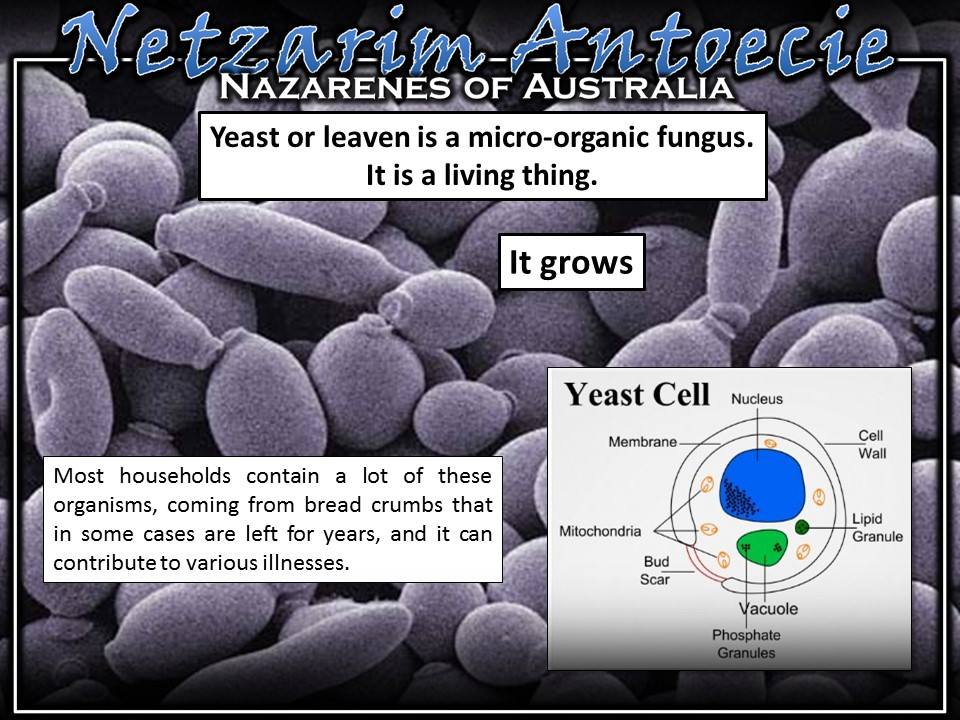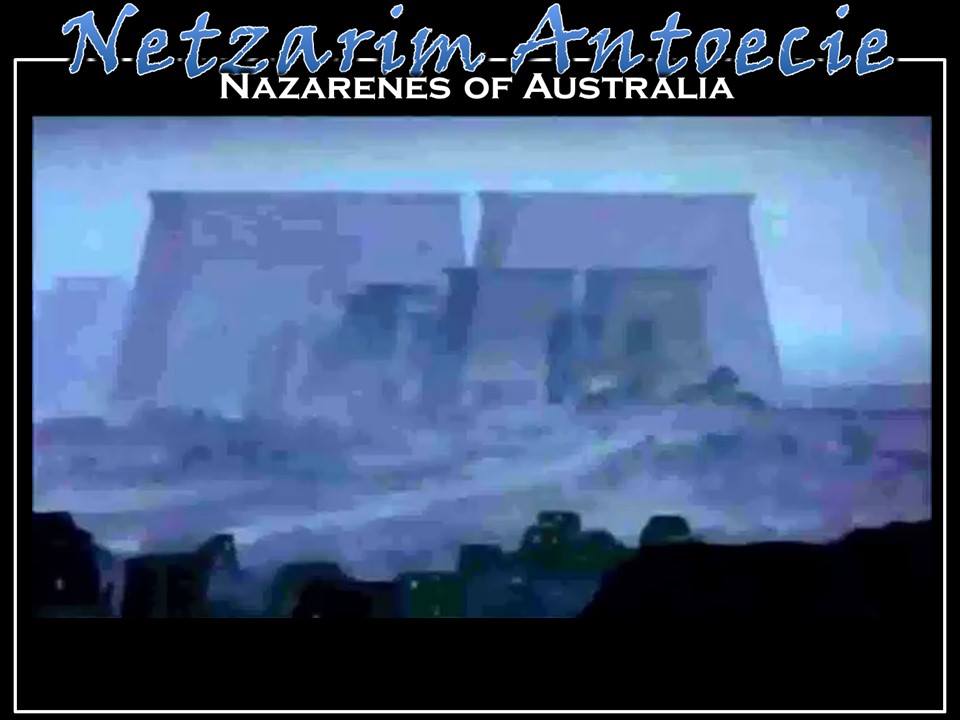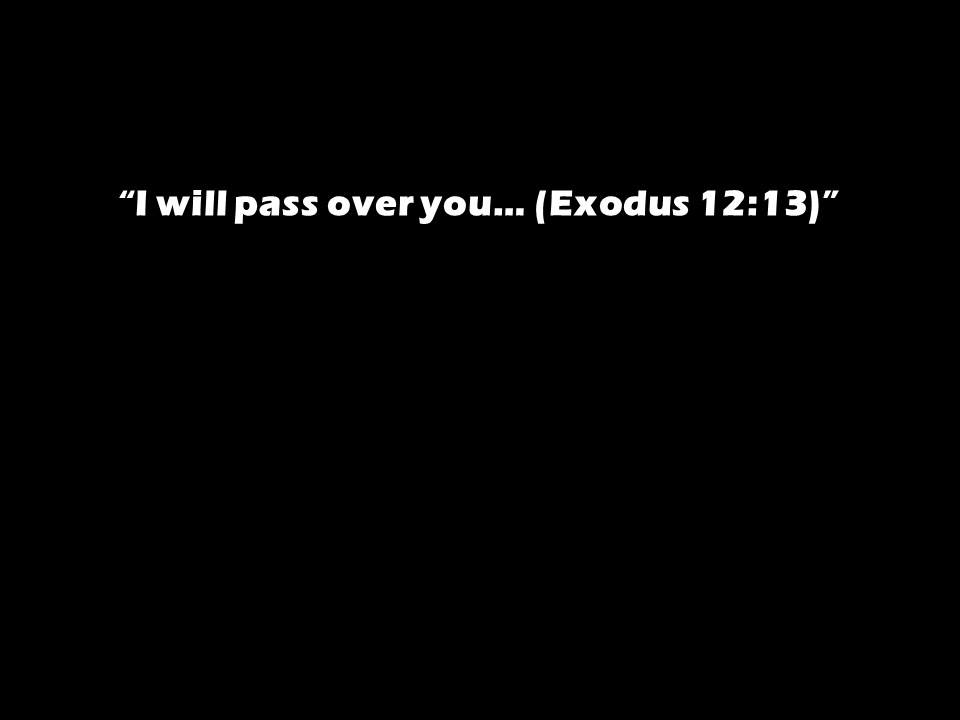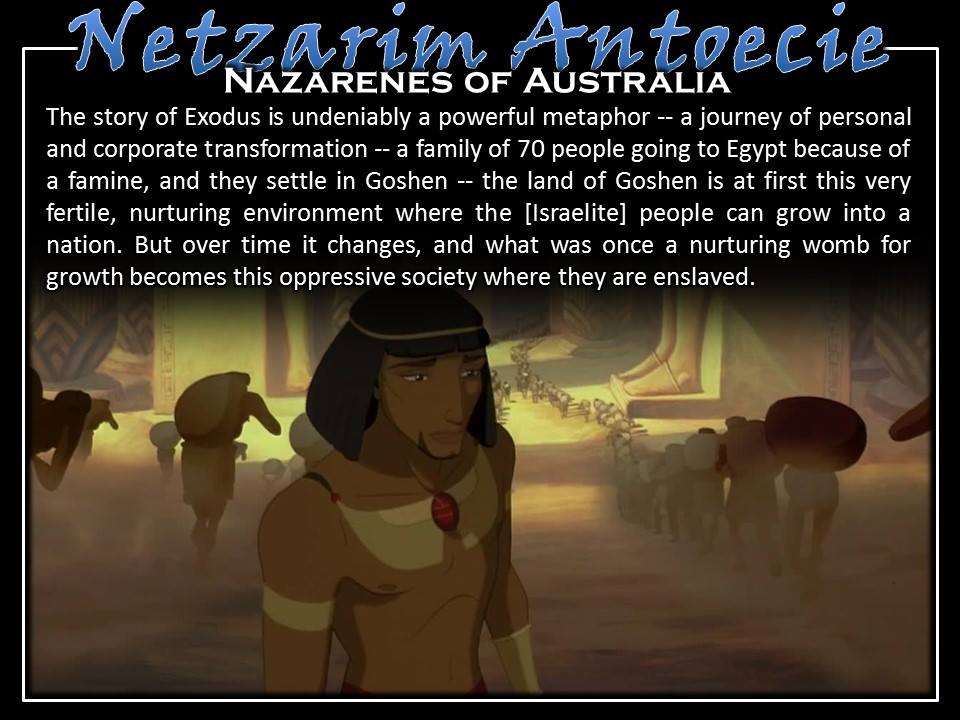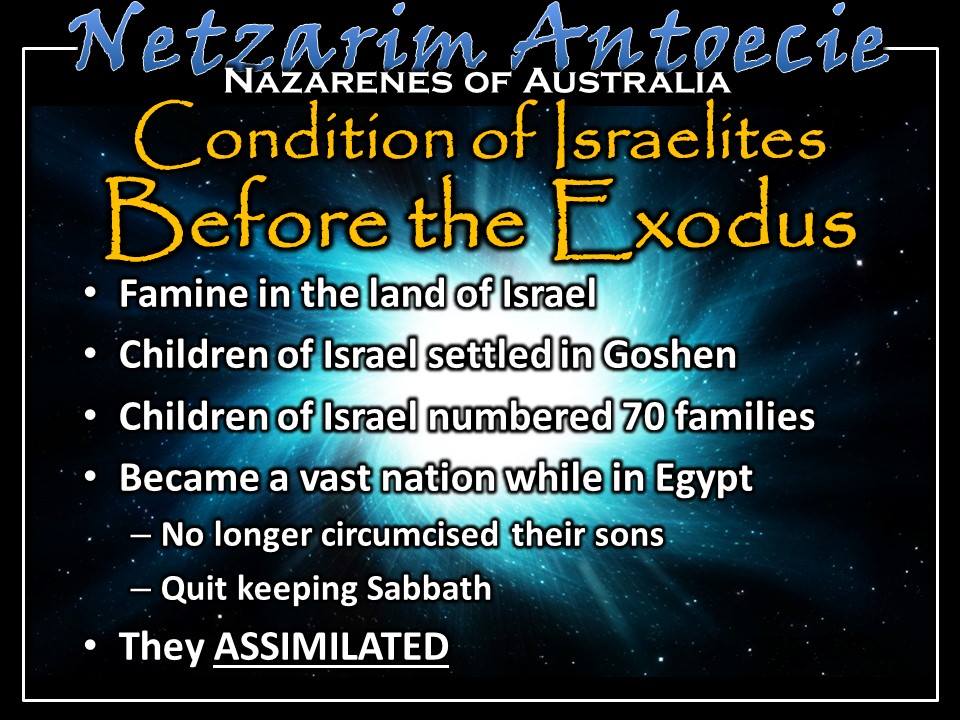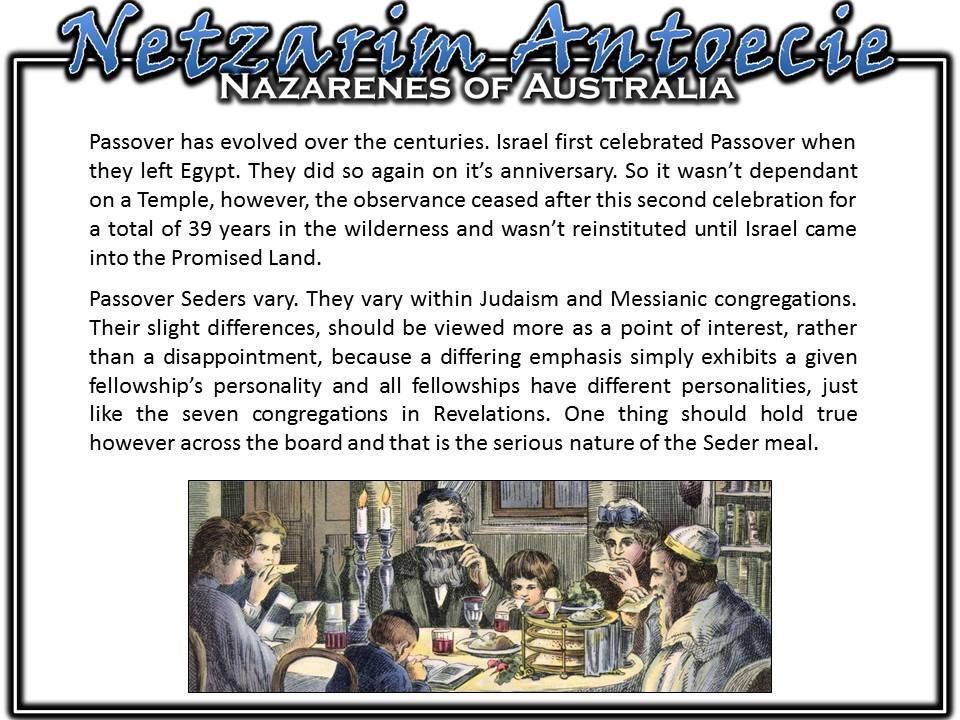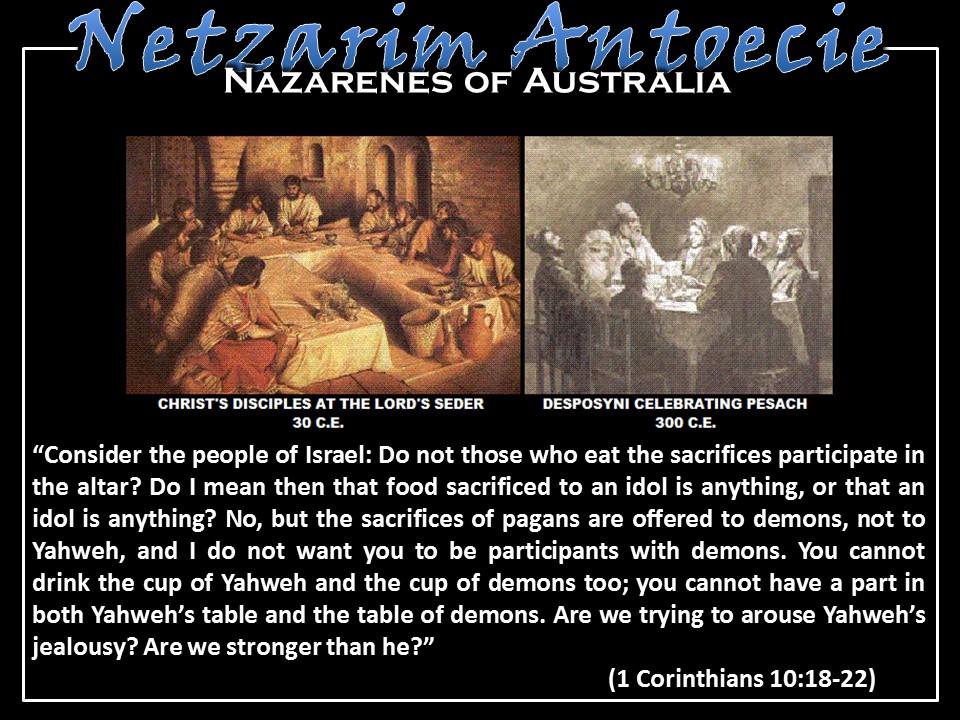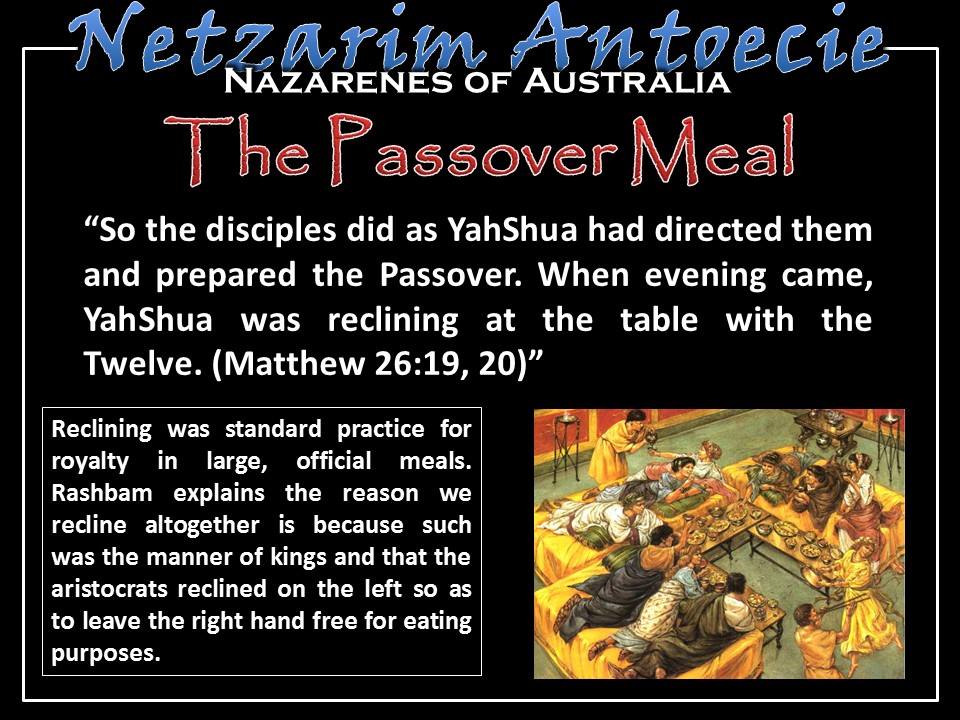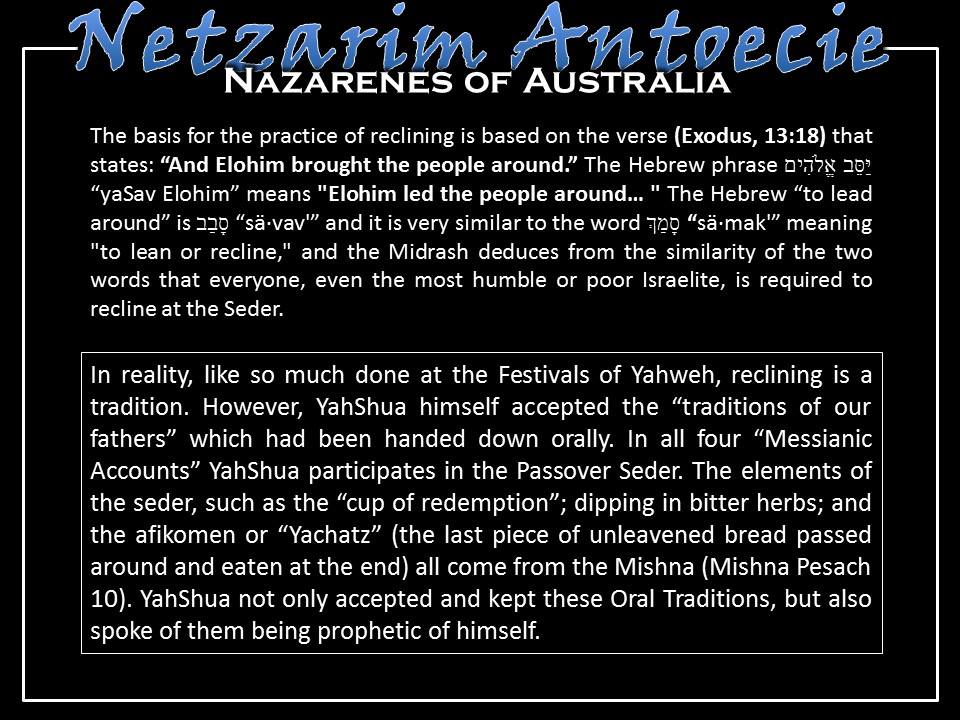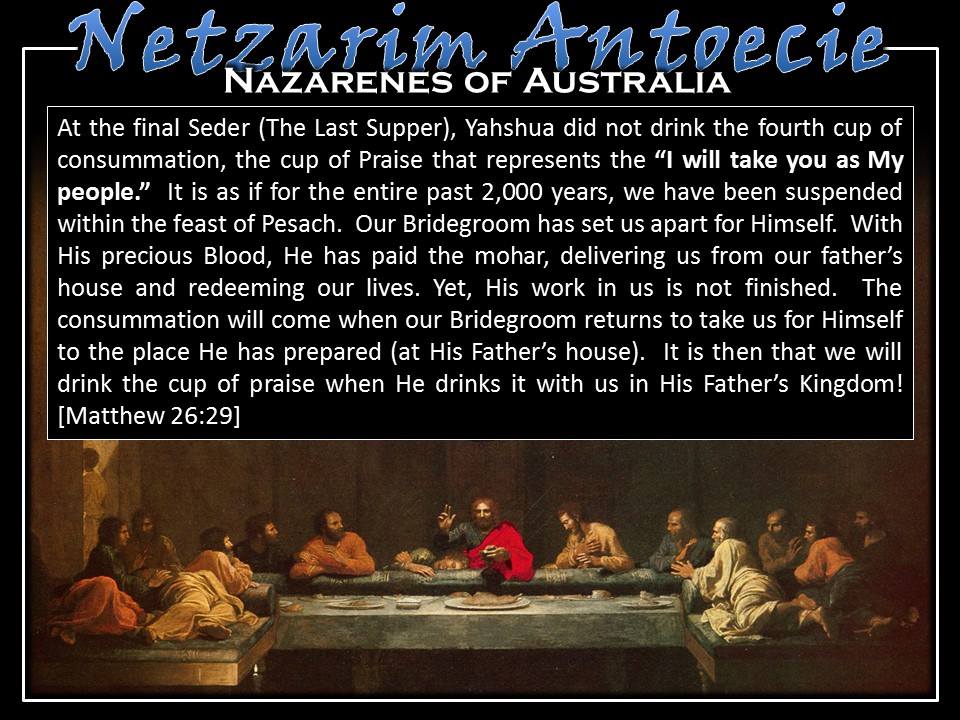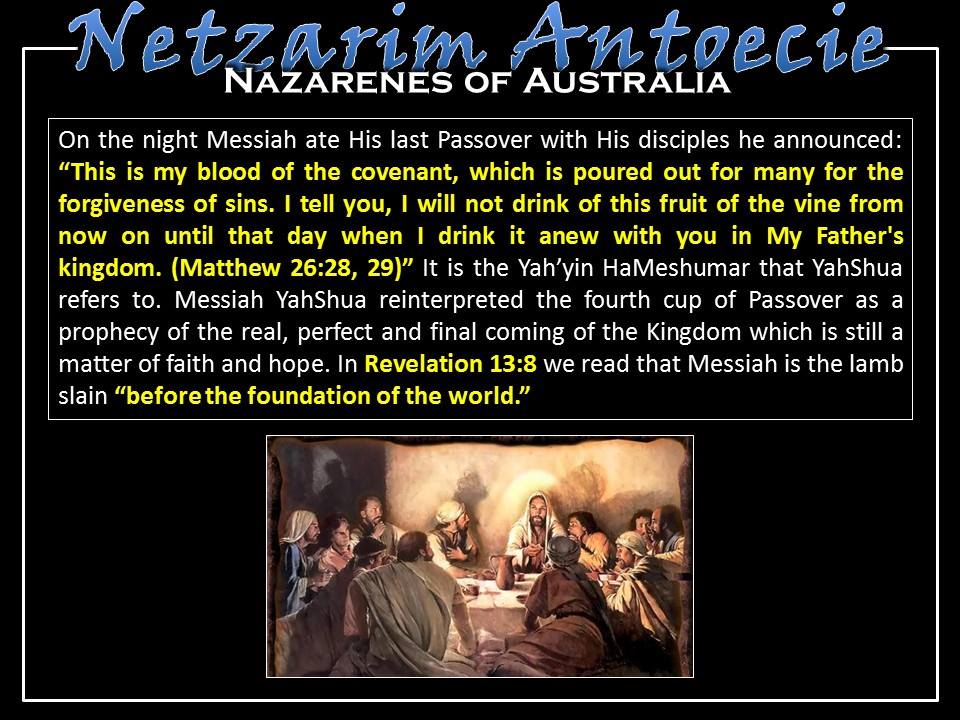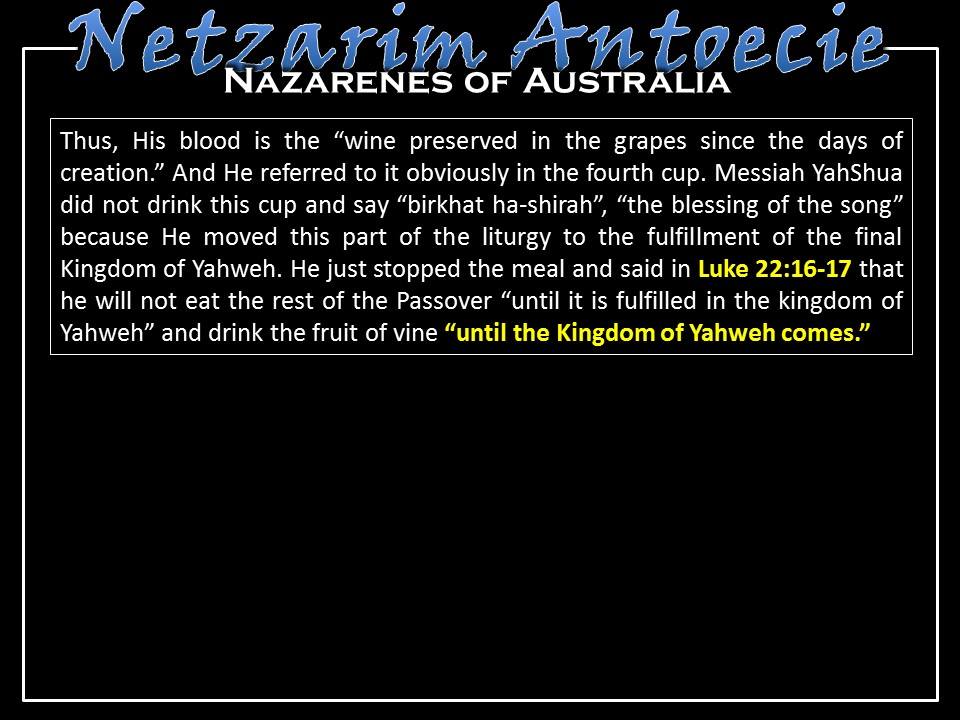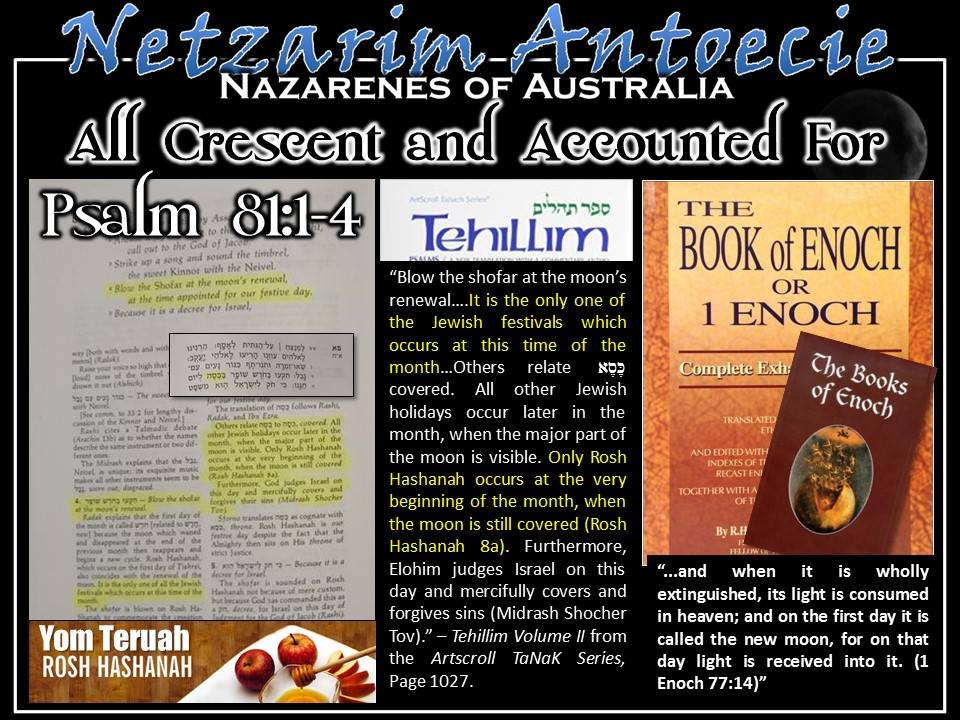Video Teaching
The Journey Continues from Passover to Shavuot [Pentecost]
Audio Teaching
Matzah – the Journey Continues
Slide 1
Introduction:
Since we have been gaining much knowledge of the Passover through the last couple of Studies & because we are in the Feast of Matzah (Chag HaMatzot) “The Feast of Unleavened Bread” I hope to expand on what we know so we can fully appreciate the significance of this Feast and the further related events such as “Sefirat HaOmer” or the Counting of the Sheaves which leads to the Feast of Weeks or Shavuot (Pentecost). Along with this significant time in the Hebrew Calendar I wish to observe what was happening with the Talmidim (Disciples) during this time as well.
Understanding the Significance of the Ten Plagues:
Often people look at all the various plagues and just come to the conclusion that YHWH was simply demonstrating his power over the forces of nature to cause Pharaoh to release the Children of Yisrael based on the reading as follows:
Slide 2
Shemoth (Exodus) 5:1 And afterwards Mosheh and Aharon went in and said to Pharaoh, “Thus
said YHWH Elohim of Yisra’ĕl, ‘Let My people go, so that they keep a festival to Me in the wilderness.’ ”
If we take a deeper look we will find something interesting though this is only seen through an understanding of the religious worship that existed in Mitsrayim (Egypt). What we do discover however is that the Mitsrites (Egyptians) had many Elohim with each attributed with different features relating to Nature so the ten plagues were particularly attributed by YHWH to totally discredit these false Elohim and to demonstrate that he YHWH alone is above all and has all power.
Slide 3
Therefore each Plague has a divine purpose to oppose a particular god or Gods as shown on the next slide:
Slide 4
The 10 Plagues- Yahweh verses the Elohim of Mitsrayim (Egypt)
We also discern from Scripture how YHWH clearly discriminated between the Mitsrites (Egyptians) and the Hebrews which can be seen throughout the first nine plagues until we reach the last plague, the plague of the death of the 1st born. Passover therefore remembers that the protection from this plague was only received by the blood of an unblemished lamb that was smeared on the lintels of the homes of those who were obedient.
This thereby teaches that the passing over of judgement for each of us is not dependent upon our righteousness but only by the humble acceptance that Yahshua’s blood atoned for each and every one of those who believe.
The Power of the Passover Lamb:
There was something uniquely powerful about the Passover Lamb. Firstly the blood on the Lintels of the door prevented the Angel of death from entering thus protecting all those within the house from facing the judgement that came upon all Mitsrayim (Egypt) but there was so much more.
We read in the following that the people left Mitsrayim (Egypt) with great blessing.
Slide 5
Tehillim (Psalm) 105:36-38 YHWH also smote all the firstborn in their land, the first of all their strength.
37 He also brought them out with silver and gold, And there was none feeble among His tribes.
38 Mitsrayim (Egypt) was glad when they departed, For the fear of them had fallen upon them.
The implication is that when the Yisraelites who were in Covenant with YHWH ate the Lamb the result was, that there were no sick or feeble among them and all the Yisraelites that left Mitsrayim (Egypt) were of such vigour that they suffered not at all from sickness or weakness even though they had been under such affliction.
The Passover Lamb representation is further expanded by the words of Yahshua in:
Slide 6
Yochanan (John) 6:53 Then Yahshua said to them, “Most assuredly, I say to you, unless you eat the flesh of the Son of Man and drink His blood, you have no life in you.
The symbolism of the Lamb is so powerful. Just as the people of Yisrael were delivered from the Slavery of Mitsrayim (Egypt) and after eating of the Lamb were empowered with strength & health so too Yahshua who is the true Lamb says that unless the people eat his flesh & drink his blood they will have no life in them but he speaks here of not the life that Yisrael had because they did die but rather his life that would impart Everlasting life. This word sadly was too much for many of his Talmidim (Disciples) that they departed from him so Yahshua asks his twelve Talmidim if they also wished to leave but Kepha (Peter) puts it so well in:
Slide 7
Yochanan (John) 6:68
68 But Shimon Kepha (Simon Peter) answered Him, “Master, to whom shall we go? You possess the words of everlasting life. 69 Also we have believed and we know that You are the Machiach (the Messiah), the Son of the living Elohim.”
So often we hear that the deliverance from sin only requires the acceptance of the blood that was shed for us but what we find in the exodus story is quite different. We read an amazing statement of trust something that we often fail to see upon a casual reading:
Slide 8
Shemoth (Exodus) 12:39 And they baked unleavened cakes of the dough which they had brought out of Mitsrayim (Egypt), for it was not leavened, since they were driven out of Mitsrayim and had not been able to delay, nor had they prepared provisions for themselves.
This verse tells us that they did not say “how will we go out into the Desert without provisions?” Instead they believed in supernatural provision & left. In the later years when Yisrael were not as faithful we see the contrast that YHWH is passionately remembering spoken through the Prophet:
Slide 9
YermeYahu (Jeremiah) 2:2 YHWH came to me saying “Go and you shall cry in the hearing of Yerushalayim (Jerusalem), saying, ‘Thus said YHWH, “I remember you, the kindness of your youth, the love of your betrothal, when you went after Me in the wilderness, in a land that was not sown.
The great truth revealed in this story is that when the Yisraelites were delivered they then began a Journey of Trust in their true Mighty One who would guide them to the place of his calling even to the land of promise but they would require faith & obedience. It is noted that YHWH their Elohim did not give them his Torah in Mitsrayim (Egypt) showing us that there must come a time of preparation and a Journey of faith through a wilderness to bring sanctification, before the people of YHWH could receive his Divine instructions they needed to develop the character of a free people through wilful obedience that would finally bring them to the Promised Land. Sadly a Journey of a few weeks took as much as 40 years before they once again came to the Boarder of the Promised land.
The Relevance of the Journey for us:
As we celebrate the Feast of Matsah (Unleavened Bread) it now becomes apparent that it is more than a remembrance of the Deliverance from Mitsrayim (Egypt) or even more than a remembrance of the sacrifice, shame & death of Yahshua the Lamb of Elohim that sets us free from the slavery of sin.
Rather it reminds us that after Deliverance, comes the Journey of faith & trust that leads us to the Torah of YHWH and hopefully to the Promised Land.
Slide 10
To further understand the concept of Leaven we need to know that Flour did not need to have Leaven added to it because it is known that Leaven is in the air so when water is added to flour it must be baked before the leavening point of 18 minutes.
How can we apply this principle to our life?
What it tells us is that Sin or Leaven is in the Atmosphere since we live in a World corrupted by sin. From the principle of Leaven we know that sin has a sin point as well, after which it becomes ingrained and begins to swell and permeate ones whole being.
If a thought or action is cut off before the sin point then the person remains unleavened thus fulfilling the Principle of purging the leaven.
So what is the problem with Leaven? It is a symbol of death & decay. The rising of the dough is only possible by means of the processes of decay & corruption. Therefore, were it not for the curse of death through the fall of Man there could be no leavened Bread. The sages identify leaven with the “Yetzer Hara” the evil inclination within.
When we purge the Leaven out of our homes we are practicing the process of removing corrupting influences from our lives. Basically it is an object lesson that we need to carry through to our spiritual lives as well.
An Example of the power of Leaven is revealed in the story of Melek (King) Shaul found in Shemuel Aleph (1Samuel 15) where Shaul (Saul) disobeys the command of Elohim and spares King Agag. This sin over time swelled so much through the hatred of Haman in the book of Esther that it almost resulted in the genocide of all the Yahudim (the Jews) in the Empire of Babylon.
The Significance of the Feast to the Talmidim (Disciples):
Firstly what is the connection to Yahshua? Unleavened bread is a picture of sanctification, purity and sinlessness. His life and sacrifice was unleavened in that he was untainted from the curse of sin therefore without spot or blemish “the ultimate Passover Sacrifice.”
The Talmidim (the Disciples) however could only see the death of Yahshua as the destruction of all hope which is further seen by their reaction to the women when they said they had seen the Master in:
Slide 11
Luke 24:11 And the women’s words seemed to them like idle tales, and they did not believe them.
Yahshua however did not suffer the natural process of corruption being the decomposition of the Body. His body did not return to dust the very curse given to Adam & Chavah (Eve)[Bereshith (Gen) 3:19] but as the 2nd Adam (Adam Hasheni) his death “killed the power of death” by putting away sin through his sacrifice.
What is even more powerful is that by his Rising, a new leaven, being the power of the Kingdom was being released not the leaven of death & decay but the Leaven of strength, power, health and Everlasting life through the RUACH Ha Qodesh (the Holy Spirit) that is available for all, that all the faithful can witness the new life that his rising would bring. We see Yahshua likening the Kingdom of Heaven to Leaven in:
Slide 12
MattithYahu (Matthew) 13:33 Another parable He spoke to them: “The kingdom of heaven is like leaven, which a woman took and hid in three measures of meal till it was all leavened.”
Yahshua’s Resurrection therefore is the raising agent that leads to life and that abundantly.
The Journey to Sinai:
When we continue to observe the Journey the Yisraelites took from Mitsrayim (Egypt) to Sinai we find it filled with disobedience and grumbling resulting in punishment and also miracles because this is the Journey that all YHWH’s people must take, on the road to embracing Torah & receiving all his instructions to finally having his Torah or his word written on our hearts. Yisrael in their stubbornness so angered YHWH that he finally declared the following:
Slide 13
B’midbar (Numbers) 14:21- 23 but truly, as I live all the earth shall be filled with the esteem of YHWH, 22 and none of these men who have seen My esteem and the signs which I did in Mitsrayim (Egypt) and in the wilderness and have tried Me now these ten times and have disobeyed My voice,
23 Shall see the land of which I swore to their fathers, nor any of those who scorned Me see it.
Fortunately we now see because of the failure of Yisrael to continue to trust YHWH, that among the Yahudim (the Jews) a humble observance of “Counting the Omer” is strictly adhered to by all devout Yahudim (Jews) as an act of repentance, something that all believers should take note of as it constitutes a daily journey of repentance and removal of leaven that we know surrounds us and that can so easily find root in us unless we purge it. This symbolizes the total rejecting of the World’s view of what life is which we know leads to slavery often seen as returning to Mitsrayim (Egypt):
Yochanan (John) 8:34 Yahshua answered them, “Most assuredly, I say to you, whoever commits sin is a slave of sin.
This counting of the Omer therefore must be highly significant as we read in Scripture:
Slide 14
Vayiqra (Leviticus) 23:15- 17 And from the morrow after the Sabbath, from the day that you brought the sheaf of the wave offering, you shall count for yourselves: seven completed Sabbaths. 16 ‘Until the morrow after the seventh Sabbath you count fifty days, then you shall bring a new grain offering to YHWH.
17‘Bring from your dwellings for a wave offering two loaves of bread, of two-tenths of an ĕphah of fine flour they are, baked with leaven, first-fruits to YHWH.
This Scripture however is where we have a discrepancy with Judaism in “the 1st Fruits & the Counting of the Omer” which begins according to Judaism two days after Passover but this does not coincide with the reading above. This counting would also contradict the 1st Fruits offering that we know Yahshua was as he is “the First Fruits of the Dead.”
Slide 15
Accordingly in the above scripture the 1st Fruits are brought on the morrow after the Shabbat and the count begins from the eve of 1st Fruits noting that Eve is before the day. Therefore based on that we are in a rare agreement with the Karaites which results in 1st Fruits & Shavuot (Pentecost) always falling on the morrow after the Shabbat.
The Spiritual Journey of the Sh’liychiym (Apostles):
Slide 16
Just as Yisrael was on a journey to Sinai so too were the Disciples. Their Journey began with the appearances of Yahshua Ha Machiach (the Messiah) on the Day of 1st Fruits & continued for the next 40 days after which he ascended into the Shamayim (Heavens):
1 Corinthians 15: 3-8 For I Shaul delivered to you first of all that which I also received: that Machiach (Messiah) died for our sins according to the Scriptures, 4 and that He was buried, and that He rose again the third day according to the Scriptures, 5 and that He was seen by Kepha (Peter), then by the twelve. 6 After that He was seen by over five hundred brethren at once, of whom the greater part remain to the present, but some have fallen asleep. 7 After that He was seen by Ya’acov (James), then by all the Sh’liychiym (Apostles).
In this journey of understanding we find that rather than what we would expect happened. Though the revelation of the Risen Saviour had been given them, the Sh’liychiym (Apostles) did not go out and preach the message of the death & Resurrection of the Machiach (The Messiah) but rather spent the next 50 days therefore the days of “Counting the Omer” in deep study of the Tanak (Old Testament) & in fellowship and much supplication that they might remove all the Leaven of the Pharisees being the false doctrines and especially hypocrisy from their lives. If they were ever going to be the bearers of this great message they needed the hand of the Almighty resting on them and they needed to be clean vessels:
Slide 17
2 Timothy 2:20 But in a great house there are not only vessels of gold and silver, but also of wood and clay, some for honour and some for dishonour. 21 Therefore if anyone cleanses himself from the latter, he will be a vessel for honour, sanctified and useful for the Master, prepared for every good work.
The days referred to as “Counting the Omer” therefore are days of preparation, of Sanctification, of purging all vestiges of Leaven that the servant of the Master is able to receive the implanted word of Truth & be fully useful to the Master. The Sh’liychiym (Apostles) needed this time of preparation even though they had been with Yahshua throughout his whole ministry observing his teaching, seeing his Miracles and now seeing him risen but yet the journey was not complete until they arrived at Shavuot (Pentecost) after which their ministry would begin.
Even at the end of 40 Days after Yahshua had presented himself to many of his growing Talmidim (Disciples) when Yahshua was about to ascend to his Father he instructed them to wait in Yerushalayim (Jerusalem) for the promise from the Father.
We see the same preparation in the life of Shaul (Paul) even though he was a Pharisee, educated in the School of Hillel under the most renowned teacher Gamali’el being the leader of the Council of Pharisees & the son of Elder Hillel yet Shaul (Paul) restrained himself from beginning his Ministry until he was adequately prepared as we read:
Slide 18
Galatians 1:11- 17 But I Shaul certify to you, brethren, that the Besorah (the Good News) which was preached by me is not according to man. 12 For I neither received it from man, nor was I taught it, but it came through the revelation of Yahshua Ha Machiach (The Messiah).
13 For I advanced in the belief of the Yahudim (Judaism) beyond many of my contemporaries in my own nation, how that beyond measure I persecuted the congregation of YHWH being more exceedingly zealous for the traditions of my fathers.
15 But when it pleased Elohim, who separated me from my mother’s womb and called me through His favour, 16 to reveal His Son in me, that I might preach Him among the Goyim (Gentiles), I did not immediately confer with flesh and blood, 17 nor did I go up to Yerushalayim (Jerusalem) to those who were apostles before me; but I went to Arabia, and returned again to Damascus.
18 Then after three years I went up to Yerushalayim (Jerusalem) to see Kepha (Peter) and remained with him fifteen days.
The key to understanding the need for preparation, sanctification & purging of the Leaven before launching into ministry is that of being overwhelmed. Think of Mosheh who for 40 years was trained in the ways of Mitsrayim (Egypt) thinking by his ability he could free Yisrael from Slavery. He then needed to spend 40 more years of humility in the Wilderness caring for sheep to the point of knowing he was totally incapable until by the calling and empowerment of YHWH he was able to trust and obey the voice of YHWH and see his people set free.
The Process of Experiencing the Journey from Pesach (Passover) to Shavuot through the days of “Counting the Omer” therefore is a much needed journey that finally leads to spiritual awakening & power, being the result of Sanctification and much intimacy through prayer with YHWH. I hope that through a greater awareness and understanding of this Journey that we can better appreciate the mechanisms that have been Divinely put in place for our benefit.
Slide 19
Summary of Discussion Points:
The plagues of Mitsrayim (Egypt) were meant to discredit the false Elohim of the Mitsrites (Egyptians) and to demonstrate that YHWH is above all & that he makes a distinction between Mitsrayim & Yisrael.
The Passover’s blood gave protection & the eating of the flesh of the Lamb brought strength & health to the Yisraelites. Therefore Yahshua raises this point by saying that all must eat his flesh & drink his blood to obtain life but this is especially speaking of Spiritual life.
After being delivered the people of Yisrael needed to walk in faith and trust for all their needs, a lesson we desperately need to learn as well. Therefore each one of us is also on that journey and it does not stop at Deliverance.
The Feast of Unleavened Bread (Chag HaMatzot) is an object lesson to remind us to deal with sin in our life since Leaven raises bread through a process of death & corruption therefore equating to sin.
The Rising of Yahshua became the New Leaven of Heaven that would affect every person who put his faith in the Master.
The Journey from Mitsrayim (Egypt) to Sinai or for us today to Shavuot (Pentecost) is wonderfully portrayed through what is known as “Sefirat HaOmer” or counting the Sheaves which relates more to a spiritual journey of preparation to receiving the Torah implanted in our hearts at Sinai/ Shavuot (Pentecost) through a countdown of daily reflection over personal refinement in our life.
Amein.





























